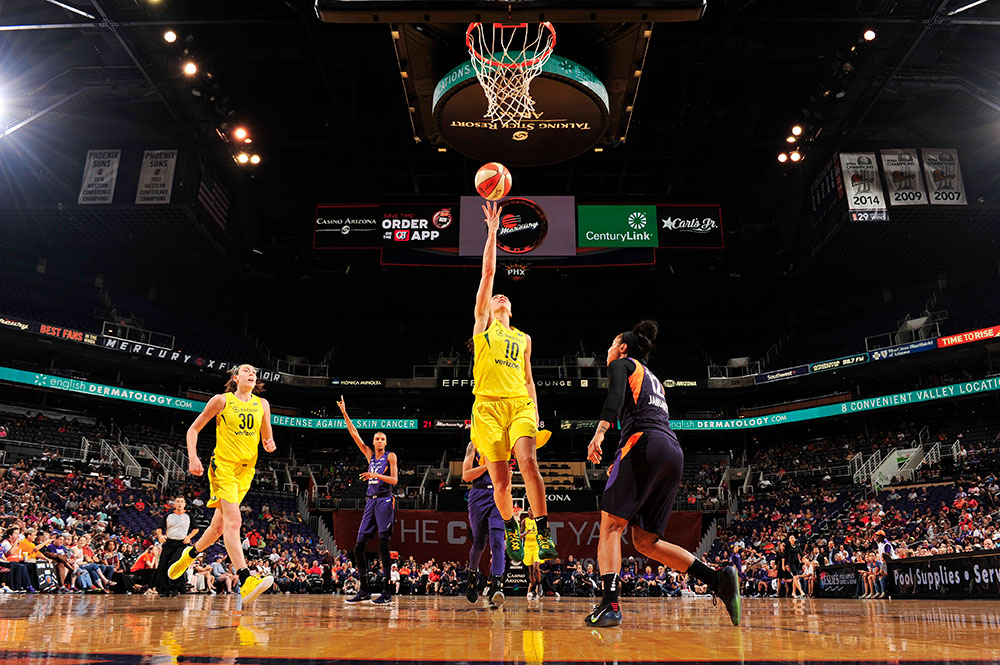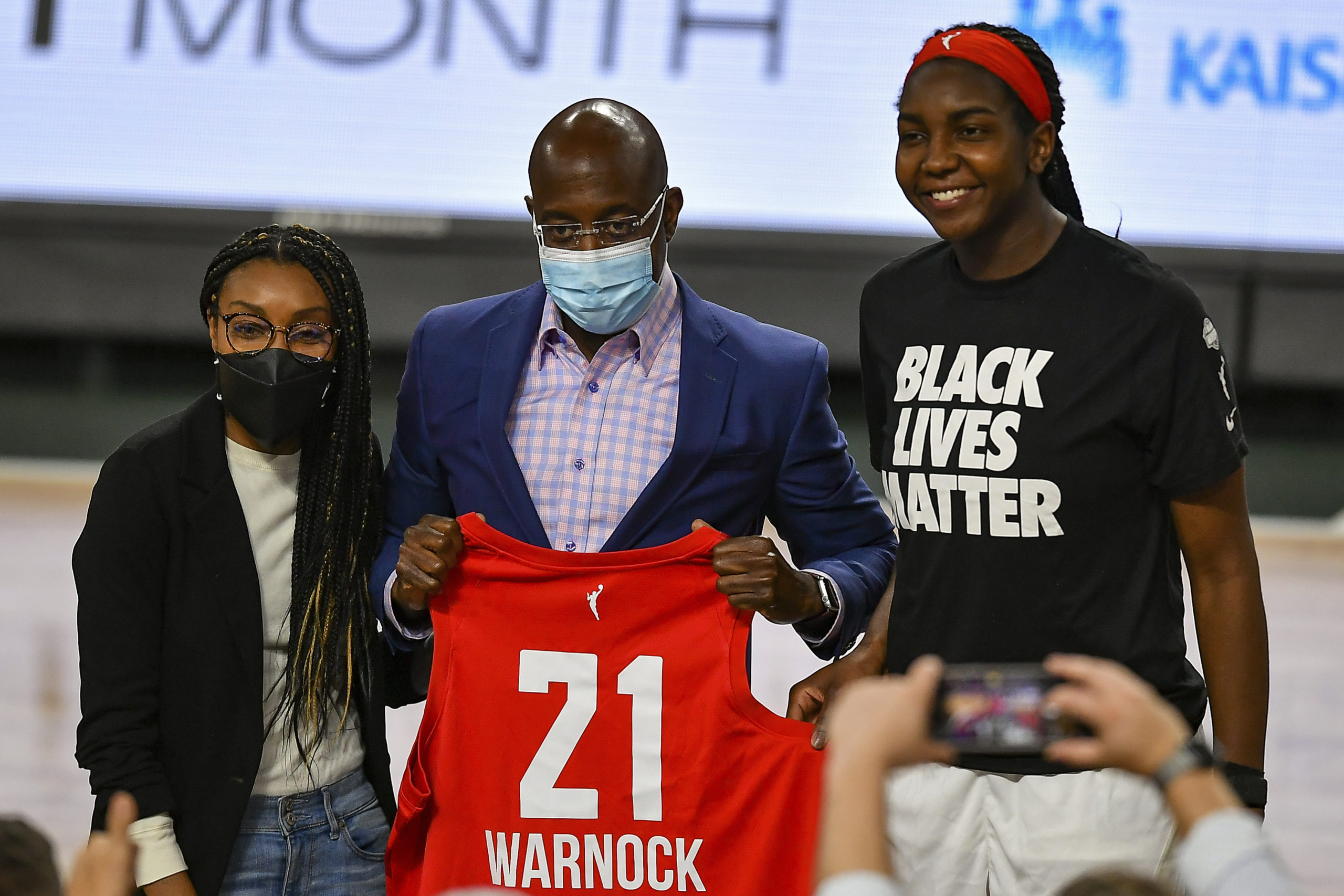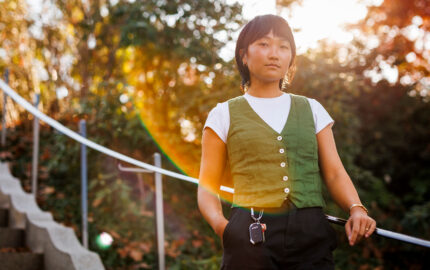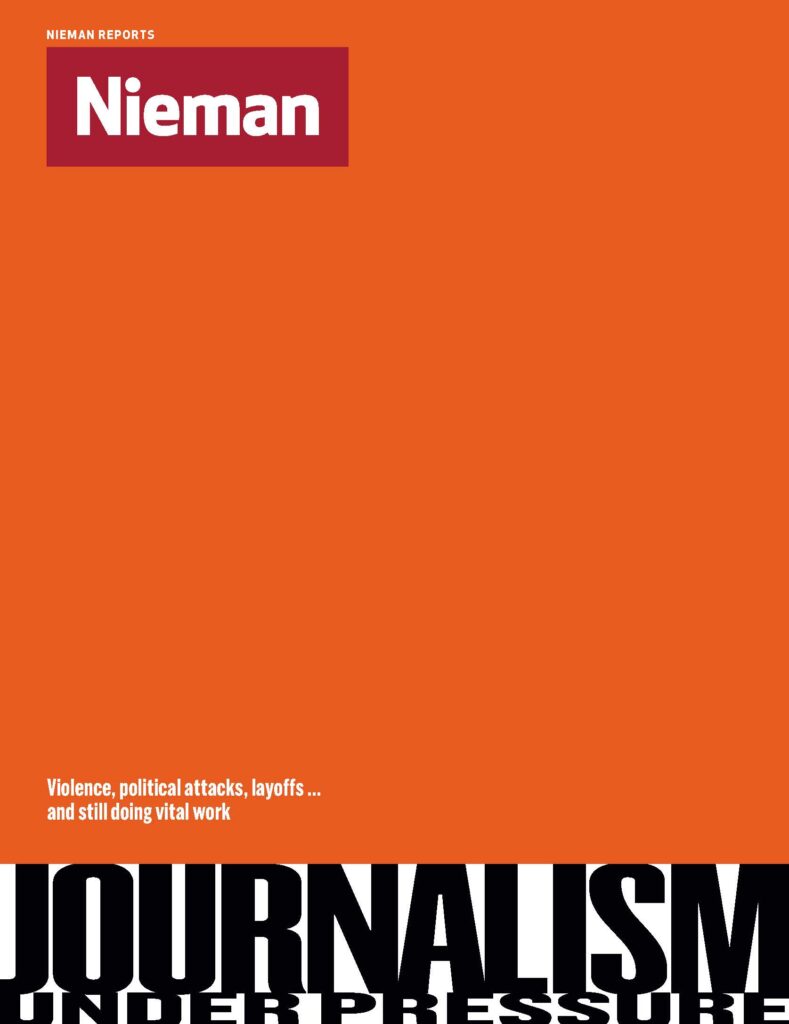
It’s no secret that the media industry—in the U.S., in Central Europe, and around the world—finds itself in deep trouble these days, struggling to stay afloat amidst all the turmoil: violence and political attacks, wavering loyalty among some audiences, and layoffs and crumbling business models aplenty. And yet, journalism, the product itself—the words, the pictures, the sounds—is in many cases thriving.
Revenue models also are a concern in Central Europe. But on top of that are the challenges surrounding the “oligarchization” of the media and repressive leaders. Still, independent outlets press on, as Lenka Kabrhelova, a journalist in the Czech Republic, reports. It’s a scary time for journalism—but it’s also an exhilarating one.
On May 18, with the NBA and NHL playoffs making headlines across the country, three of the four stories on the front page of the Minneapolis Star Tribune sports section focused on women’s sports, including the WNBA’s Minnesota Lynx. On September 7, with the NFL starting up, college football rumbling along, and Major League Baseball nearing the playoffs, The Seattle Times wrapped its sports section in a poster of the Seattle Storm’s biggest stars, 11-time WNBA All-Star Sue Bird and 2018 WNBA MVP Breanna Stewart. Inside, there were two and a half pages devoted to the women’s basketball team and its upcoming WNBA Finals matchup against the Washington Mystics.
As someone who covers stories at the intersection of sports and society, it’s hard to ignore what’s happening with women’s sports coverage—and what’s not
If these sections were your introduction to America’s obsession with sports, you might have thought women’s sports generated more interest than men’s sports. The reality is far different.
In July, NBA summer league games got far more mainstream media coverage than WNBA regular season games. Every day, men’s sports stories dominate the 10 most popular sports websites. The bigger picture: women’s sports in the U.S. receive only 4 percent of sports media coverage, according to the Tucker Center for Research on Girls & Women in Sport at the University of Minnesota. In a study of televised sports news, ongoing since 1989, three LA-based stations dedicated, on average, 3.2 percent of their sports coverage to women’s sports, according to the 2014 results, the latest available.
Related Reading

Covering Women's Sports
WNBA superstar Sue Bird rates sports coverage and finds room for improvement
“We had days where we were collecting data on local news broadcasts or on ESPN’s ‘SportsCenter’ and there would literally be no coverage of women’s sports,” says Purdue University associate professor Cheryl Cooky, a co-author of the television study. “But the local network would spend 55 seconds out of their three minutes of sports content talking about a stray dog that had wandered into the Milwaukee Brewers stadium. And it’s like, ‘The women’s NCAA basketball tournament is going on and you can’t talk about the tournament but you can find time to talk about a stray dog going into a stadium?’ There’s a lot of missed opportunities with respect to helping build audiences for women’s sport.”
There are also signs of change, thanks in part to vocal critics, social media, and a rash of sports media startups eager to build bigger audiences. “There are people in women’s sports who are demanding better coverage,” says former Sports Illustrated sports media reporter Richard Deitsch, who now writes for The Athletic. “Lynx coach and general manager Cheryl Reeve is the ultimate example. She’s basically called out media people on Twitter. And I think her actions have worked.”
One of her targets on social media: The Athletic. On Twitter, she asked “Why would a subscriber-based sports medium that claims ‘full access to all sports’ limit its earnings potential by not covering women’s sports?? The Athletic does just that … and it’s bad business. #tiredofthebias.” This season, the website assigned two writers to almost every Lynx game and practice. While regular Lynx coverage was something the website said it always planned to do, Reeve’s outspokenness drew wider attention to the issue and undoubtedly prompted faster action.
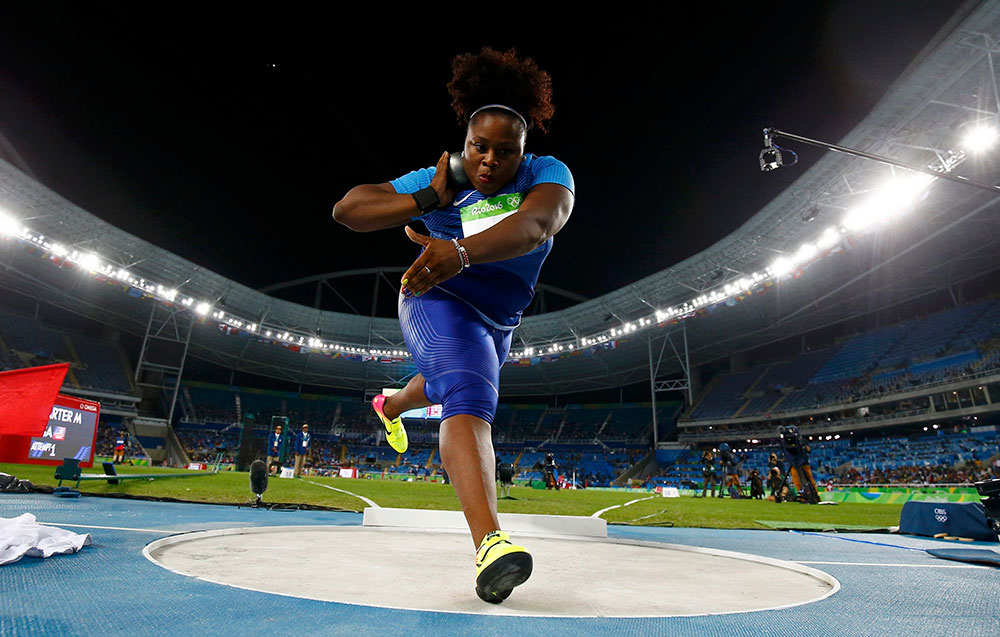
This fall, The Athletic held organizational meetings to discuss its approach to content in 2019 and beyond. So, how does women’s sports coverage fit into The Athletic’s plans for growth? Paul Fichtenbaum, chief content officer for The Athletic, says, “We’re right in the middle of it so I’m not comfortable making projections. But we’re having a thoughtful discussion internally on the best approaches. We want to cover women’s sports. It is on the agenda and we’re serious about it.”
But even when women’s sports do get covered, a number of studies have found, the focus is often on femininity and attractiveness, not athleticism. Also, in 2017, Cooky and her fellow researchers highlighted what they call “gender-bland sexism.” That is when sports commentators downplay the accomplishments of female athletes and convey less excitement about big wins or milestones. “To me, it’s like, if we can’t sexualize them, then we’re just not going to really talk about them at all,” says Cooky. “Or, if we have to talk about them, then we’re just going to talk about them in really boring and bland ways.”
As a sports journalist for more than 20 years, I covered one of the most thrilling college basketball games of all-time (No. 16 Harvard upsetting No. 1 Stanford in the first round of the 1998 women’s NCAA basketball tournament) and one of the most historic World Cup games ever (the 1999 women’s soccer final between the U.S. and China before 90,185 fans at the Rose Bowl). After that, I became the Celtics beat writer for The Boston Globe and went on to cover the NBA Finals, the Stanley Cup playoffs, the Super Bowl, the World Series, and the Olympics with a smattering of WNBA games, women’s pro soccer, and the National Women’s Hockey League thrown into the mix when time, space, and the sports budget permitted.
Now, as someone who covers stories at the intersection of sports and society for public radio and writes regular columns for The Boston Globe and the SportsBusiness Journal that focus on women’s sports, it’s hard to ignore what’s happening with women’s sports coverage—and what’s not.
More and more, female journalists, athletes, and coaches, as well as fans of women’s sports are clapping back, launching sports podcasts, crowdfunding sports websites, and advocating for better women’s sports coverage. They’re introducing new voices and experimenting with different approaches to coverage in niche publications. They’re showing how women’s sports and women’s perspectives on sports can be entertaining, compelling, and potentially money making.
That’s crucial. Because sometimes the dearth of coverage is about economics more than anything else.
If women’s sports stories don’t lead to more subscriptions or more viewers, then decision-makers question whether those stories are worth the investment of time, money, and talent. If women’s pro soccer matches or women’s pro hockey games barely draw crowds, then it’s hard to justify sending a senior reporter or columnist to cover them, especially for newspapers fighting for survival.
Even when women’s sports do get covered, the focus is often on femininity and attractiveness, not athleticism
For the Globe, a combination of factors has pushed aside women’s sports coverage. They include a shrinking sports staff, fewer print pages, and a focus on digital subscriptions. The paper believes it can survive by increasing digital subscriptions from its current 109,000 to 200,000. To do that, the Globe sports section has concentrated almost exclusively on what drives digital subscriptions. And all the internal metrics show that the city’s four major men’s professional teams—the Red Sox, Patriots, Celtics, and Bruins—create the most buzz on BostonGlobe.com.
“So, that’s where we’ve devoted most of our resources,” says former Globe sports editor Joe Sullivan, speaking about his department’s approach before he recently retired. “We’ve added more people into covering the Red Sox, Patriots, Celtics, and Bruins, as much as we can, to get people to come to BostonGlobe.com. We want people in California to get subscriptions to read about the Red Sox. What falls by the wayside? Women’s sports in general. College sports have fallen by the wayside for us, too.”
For new Globe sports editor Matt Pepin, the decision tree looks the same. When it comes to women’s sports, Pepin says, “We’ll cover it when we know the stories have something that lifts them above a niche audience and gives them broad appeal.” One example of when that’s happened under his leadership: In November, the Globe sent a reporter to Killington, Vt. to cover 23-year-old skiing phenom Mikaela Shiffrin.
Still, among legacy news organizations, the Star Tribune and Seattle Times are outliers. Rana Cash, formerly assistant sports editor at the Star Tribune, knew she had something special in Minneapolis with the Minnesota Lynx, winners of four WNBA titles. “The Lynx have high engagement in terms of reader interest so our coverage reflects that,” says Cash, who became sports editor of the (Louisville, Ky.) Courier-Journal on Oct. 1. Meanwhile, Seattle Times sports editor Paul Barrett sees something special in the Storm, the 2018 WNBA champions. When the team made the Finals, he says, the paper simply had “an opportunity to do something big for this big event and jumped on it.” He adds: “As a newspaper, I feel like it’s our duty to cover as many things as well as possible and give readers a well-rounded experience, and inform and entertain. I don’t think what we should do is just pound people with Seahawks, Mariners, and [University of Washington] Huskies coverage only and ignore everything else, even if that makes more sense from a business perspective.”
While a grassroots push for better coverage of women’s sports is critical, it’s still a top-down media world with change almost always spurred by major outlets with broad reach. Here’s a look at what sports outlets and journalists are doing to improve coverage. And what they should be doing more.
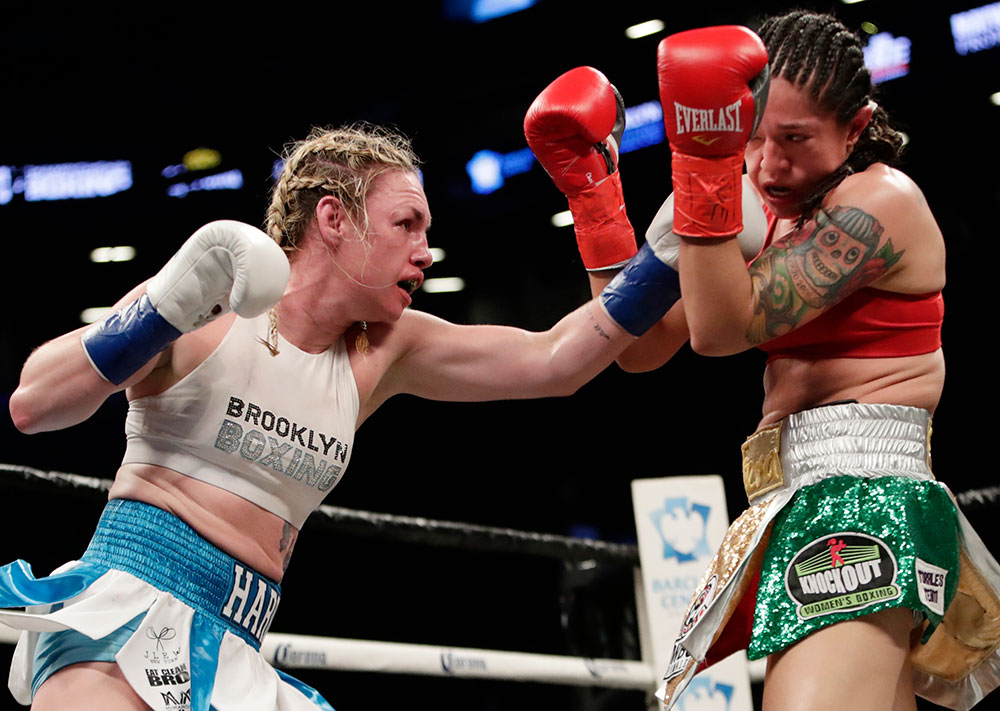
Commit to consistent coverage
If news organizations don’t commit to consistent women’s sports coverage, then they’re helping perpetuate the biased, inaccurate belief that fans don’t care about women’s sports. You can’t build a following for women’s sports when fans don’t know when or where they’ll find games or features or in-depth analysis. “Women’s coverage wouldn’t be around four percent if we had consistent coverage that wasn’t cyclical,” says the Tucker Center’s co-director Nicole LaVoi. “If you could follow women’s sport in season and out of season, around the calendar like we do men’s sport, then that would change the landscape.”
The Seattle Storm’s Sue Bird agrees and adds: “There are story lines that get missed without constant coverage throughout the season.” Those story lines might focus on a scoring streak, a comeback from injury, or a quest for a franchise record. What matters most is that the story lines get followed day-to-day or game-to-game.
The Star Tribune and its Lynx coverage offer a model of consistency. Even with a budget that limits travel during the pre- and regular season, Cash and Lynx beat writer Kent Youngblood have made sure Lynx road games get covered either by stringers or game stories compiled by copy desk editors. Cash says the paper’s consistent Lynx coverage has paid off with a strong following. She’s heard plenty from readers who can’t get enough Lynx stories. The demand has been significant enough that, before Cash left for Louisville, she constantly thought about ways to offer more coverage from podcasts to newsletters to analytics packages.
Sports fandom, the kind that leads to website traffic, higher ratings, and newspaper subscriptions, is about more than coverage of a tournament or big race or championship game. So much of fan culture relies on getting to know athletes and building anticipatory excitement, understanding strategy, knowing statistics, and arguing about contracts, trades, and lineup changes. All of that takes consistent, day-in and day-out coverage that makes an audience hungry for more.
Focus on lesser-known stories and tell backstories
Outside magazine’s regular online feature the “Badass Women Chronicles” started with a casual brainstorming conversation at the magazine’s headquarters in Santa Fe, New Mexico. Digital editorial director Axie Navas was talking with associate editor Molly Mirhashem about the magazine’s coverage of well-known, monumental male firsts. “Like Edmund Hillary, the first man to summit Everest,” says Navas.
It’s exactly the kind of conversation you’d expect at Outside Magazine. But the conversation didn’t stop with Hillary and male firsts. The editors began thinking about Junko Tabei, the first woman to summit Everest. “Her story is much less known,” says Navas. “Out of that came this idea: There are a lot of records that we just haven’t talked about that are insanely impressive and really good stories that we’ve never covered.” And those stories often belong to women.
Like inconsistent coverage, mysteries and misconceptions make it hard for women’s sports to build a passionate, loyal following
The first installation of the “Badass Women Chronicles” appeared online in October 2017. Since then, the chronicles have profiled seamstress-turned-champion-cyclist Tillie Anderson, who raced during the Victorian era, and swimmer Gertrude Ederle, who became the first woman to cross the English Channel in 1926 and reached the other side two hours faster than all the men before her. Outside aims to publish two online stories per month under the Badass banner.
And there are plenty more lesser-known stories waiting to be discovered, plenty more female pioneers from the past and elite female athletes from today with unique histories that deserve more attention.
“When you know the backstories of players, of teams, of leagues, and those stories are told, people are more likely to latch on,” says Bird. “I just don’t know that our stories are told. I think our lives are these big mysteries and you can see it in all the misconceptions that are out there about who we are, what we do, what we ask for, what we don’t ask for, how much money we make, how much money we don’t make, everything across the board.”
Like inconsistent coverage, mysteries and misconceptions make it hard for women’s sports to build a passionate, loyal following.
Bring in more women and encourage male allies
Men far outnumber women in sports media. The 2018 Associated Press Sports Editors (APSE) Racial and Gender Report Card found that, at major newspapers and websites in the U.S. and Canada, 90 percent of sports editors are male and 85 percent are white. In 2015, a report by the Women’s Media Center stated that women generated only 10.2 percent of sports coverage.
More effort needs to be invested in finding, hiring, and developing talented women because when women create content the conversation around sports changes in unexpected ways. See Navas and Mirhashem. Yet the responsibility for more and better women’s sports coverage shouldn’t rest entirely with women. Male allies need to raise their voices, too, whether it’s academics who study women’s sports or journalists who champion great stories about female athletes or Her Hoop Stats founder Aaron Barzilai, the former director of basketball analytics for the Philadelphia 76ers who turned his attention to women’s basketball.
Still, women are often behind the most different, unanticipated perspectives.
Look at what happened when marathoner Lindsay Crouse, who produces OpDocs at The New York Times and occasionally contributes to the paper’s sports section, took a closer look at the results from the 2018 Boston Marathon. She observed that women finished at higher rates than men in terrible conditions, including freezing temperatures, rain, and 30-mile-per-hour headwinds. Crouse wrote a Times opinion piece entitled “Why Men Quit and Women Don’t.” And she says, “Part of why I even thought of this in the first place was because I’m a woman. So, I think you need more women in the space seeing the ways women succeed.”
Having women in brainstorming and decision-making positions makes an undeniable difference when it comes to finding and prioritizing more diverse and more inclusive narratives. “We have some really strong editors who happen to be women,” says Navas. “They’re often thinking about different parts of the sports world that we might not be covering and they’re bringing in new writers who we might not have found.”
When women create content, the conversation around sports changes in unexpected ways
When it comes to the value of women in decision-making positions, Alison Overholt, editor-in-chief of ESPN The Magazine and espnW, echoes those points and says, “It’s crucial. It matters tremendously because you will notice and you will tease out different ideas and you will amplify different voices and open the door for different people.”
Change the culture in sports departments
More women assigning, writing, editing, and producing sports stories doesn’t automatically translate to more women’s stories. Consider The Washington Post’s sports staff. It has boasted four women covering the four major Washington, D.C. men’s pro sports teams. That represents progress and gender bias at the same time. Most sports journalists, male and female, want to cover men’s sports. Why?
“Because that’s what the culture values,” says Cooky, who teaches courses on feminism and “Sport in American Culture” at Purdue. “That’s where the status is. That’s where the opportunity for career growth is.” Meanwhile, the bylines for women’s sports stories often belong to junior reporters, part-timers, or interns. Young journalists assigned to women’s sports teams typically view it as a first step toward bigger and better opportunities, particularly at large, traditional media outlets.
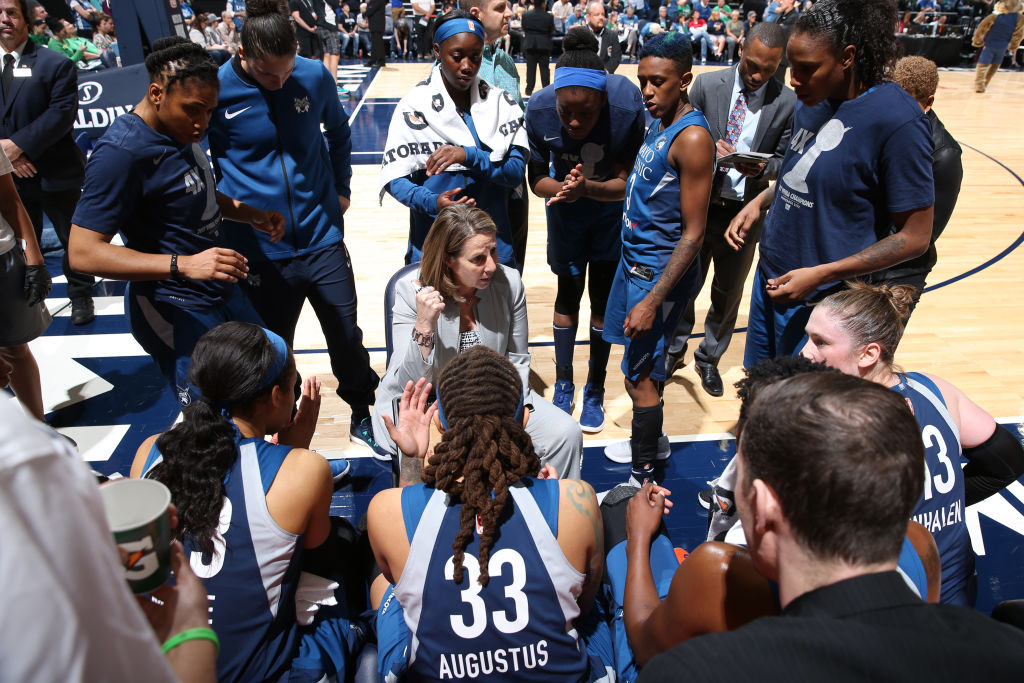
By contrast, at the Star Tribune, Lynx beat writer Youngblood is a veteran sports reporter who’s been in the business for 28 years and covered three of the four major men’s professional teams in Minnesota—the Timberwolves, Vikings, and Wild—and the Green Bay Packers. He’s been on the Lynx beat since 2013 and says, “I cover the Lynx the way I would cover the Timberwolves or the way I would cover the Vikings.” During the WNBA season, Lynx stories appear almost daily, Lynx players and coach Cheryl Reeve find themselves the focus of lengthy profiles, and columnists attend Lynx home games fairly regularly.
Youngblood ranks the Lynx “at or near the top” of the beats he’s covered because of the team’s success and accessibility. “It’s a pleasure to cover the Lynx,” he says. “It’s fun because as a writer, if you have ideas, they’ll work with you to do them rather than fight you.” More journalists, editors, and producers need to appreciate the opportunities that come with covering women’s sports and take advantage of them. If they do, it could establish new paths for career advancement and set more significant changes in motion.
Prioritize storytelling
Since launching in 2010, espnW has become the most prominent platform dedicated to women’s sports and female athletes. The number of unique monthly visitors to espnW ranges from three to five million, though you often have to scroll way down the ESPN homepage to find espnW–branded content. There’s also frequent criticism that ESPN and, by association, espnW could do more for women’s sports. That comes with the territory when a media outlet calls itself the “worldwide leader in sports.”
Since launching in 2010, espnW has become the most prominent platform dedicated to women’s sports and female athletes
Yet when you take a deep dive into the site, it appears there’s something for everyone. Here’s a sampling: a long-form feature on a young Nepalese golfer with pro aspirations, multiple perspectives on the controversies at the U.S. Open involving players Serena Williams and Alize Cornet, a personal essay on lessons learned from shot putting, a piece on college volleyball star Lexi Sun and why she transferred to Nebraska, a game story from the National Women’s Soccer League final, a look at the workout Olympic rower Grace Luczak loves to hate, a slideshow featuring the top-12 players in girls high school basketball, and a profile of a 73-year-old orienteering legend.
“We talk a lot about the value of storytelling,” says editor-in-chief Overholt. “We talk about opening up the stories of women athletes and women’s sports to existing fans and also to the folks who may not have known, until the moment they read a story, that they could become fans of women’s sports. What we’re now really seeing is an emphasis on taking that women-centric storytelling and having it go everywhere at ESPN.”
The long-form piece on Nepalese golfer Pratima Sherpa originated on espnW, then it was broadcast as part of the SportsCenter Featured documentary series. Coverage of the WNBA’s 20th anniversary started on espnW, then it expanded into a package for ESPN The Magazine. Stories travel in the reverse direction, too. The Undefeated’s article about a young, black, female tennis player fighting racist trolls found its way onto the espnW site.
Deliver knowledgeable coverage
Lynx coach and general manager Cheryl Reeve wants reporters to dive into the complexities of the WNBA and be critical. “That’s when you know you’ve made it,” she says, “when they are covering you the same as the men and they are critical, critical of me, critical of a player.” But it takes knowledge of women’s sports to understand its complexities, offer legitimate criticism, and tell great stories. “The only way you can do that is to be present more than once a week,” says Reeve. “You have to watch other games. You have to know the upcoming opponent. You have to understand matchups. You have to understand how we play.” The same logic applies to men’s sports. The difference: The information needed for deep, granular knowledge of women’s sports is a lot harder to come by than the same information about men’s sports. And that means it often requires more time and more dedication to follow and to cover women’s sports.
In women’s sports, statistics that go beyond the basics can be hard to find
Take statistics. They put players in historical context. They encourage the kind of debate that fuels sports passion. They also reveal the trends and anomalies that inspire a diverse array of stories. The more statistics available, the more knowledgeable reporters and fans become. The more knowledgeable, the more engaged. It’s been that way for decades in men’s sports. But in women’s sports, statistics that go beyond the basics can be hard to find. It’s a problem the website Her Hoop Stats hopes to solve for women’s college basketball. Founded in December 2017 by Aaron Barzilai, former director of basketball analytics for the Philadelphia 76ers, Her Hoop Stats “aims to provide consistent, reliable, and easy-to-access data about women’s basketball” and “help grow the women’s game by providing effective new tools to better understand it.” In August, Basketball Reference introduced a database for the WNBA, allowing reporters and fans to search the entire history of the league for player stats. It’s progress, though the site has 15 searchable databases for the NBA.
Give women in sports more of a voice
Better quality coverage would look a lot like the coverage male athletes get. That means not only a focus on the athleticism and accomplishments of female athletes, but also a willingness to dive into the complicated, conversation-worthy narratives in women’s sports. That’s what comes through when the co-hosts of the feminist sports podcast “Burn It All Down” start talking. “The first thing is to not be afraid of complexity,” says co-host and ThinkProgress sports reporter Lindsay Gibbs. With female athletes, Gibbs finds too often they’re boxed into an inspirational storyline, or portrayed as either a perfect person or a villain. “It’s kind of an offshoot of the Madonna/whore [complex],” says Gibbs. “The truth is that like most male athletes, most women are somewhere in between, even the great ones.”
How should journalists find and tell stories about women’s sports? Start by framing ideas and asking questions in ways that aren’t gender-driven. If you focus on gender first, then you’re not truly committed to telling great stories. If you take a checklist approach to stories about female athletes, then it will likely lead down a path cluttered with women’s sports narratives that fall into clichéd categories about overcoming sexism or coming back from pregnancy.
At NPR’s hour-long weekend sports show “Only A Game,” senior producer Karen Given and her staff judge pitches on whether they present a compelling narrative. I contribute to the program and, during story meetings, have seen this in action. The initial conversation about pitches is gender-blind, not gender-driven. Sometimes that leads to an entire show filled with stories about women. Sometimes athletes tell their own stories without narration.
“One of the things that non-narrated stories allow you to do,” says Given, “is let people define the impact of struggles on their own life, rather than have reporters define it for them.” That’s especially important for female athletes because, as Given adds, “oftentimes women’s sports coverage focuses on the fact that it’s about women and not the fact that it’s about sports. When you let people describe their own lives, gender might be an important factor to them or it might not be.”
Boxing champion Heather Hardy told her story to “Only A Game” in her own words. The 10-minute piece hits on familiar, arguably cliché, themes like overcoming economic adversity, fighting for equality, and balancing motherhood with an athletic career. But hearing Hardy describe her life story makes it feel different and more intimate. Given loves how “it’s a story about a person who has been discriminated against, but who has never been a victim.” It’s also a reminder of how much language and storytelling style matter when covering women’s sports and female athletes.
Describing her first fight, a kickboxing match, Hardy says, “Here I am the shyest girl in the world. Like I’m the girl who will walk into a room and sit by myself. But for whatever reason, walking through that crowd of 2,000 people with the spotlights and the radio on and standing in the ring and beating this girl up so bad, I felt like a million puzzle pieces came together and just told me, ‘This is what you’re here for. This is your life.’”
By devoting prime real estate to women’s sports, the Star Tribune and The Seattle Times challenge the bottom-line, metrics-driven thinking that leads editors to prioritize men’s coverage as the safest bet
Giving female athletes more of a voice helps avoid some of the issues that often plague women’s sports coverage. That’s the all-too-common focus on femininity, attractiveness, and biology.
In June, The New York Times faced criticism for an article entitled “America’s Next Great Running Hope, and One of the Cruelest Twists in Youth Sports.” The piece profiled high school phenom Katelyn Tuohy, and “one of the cruelest twists” was the fact that “so many gifted teenage female distance runners fizzle out by their early 20s.” That happens because young women’s bodies change dramatically during their teenage years. So, you can see the problem with describing the natural maturation of the female body, one that often involves filling out and gaining weight, as a cruel twist. But there’s also this: Recognition of Tuohy’s astounding, record-breaking success came with a sense of foreboding because of her gender.
That’s the real cruel twist. Too many profiles of female athletes contort success into something that comes with qualifiers, whether it’s the implication that it might not last or, most commonly, the comparison to male athletes in the same sport.
Moving forward
To create an environment where women’s sports and women’s sports coverage are valued, reporters, editors, players, coaches, academics, and others need to challenge the sometimes blatantly sexist, sometimes ignorantly biased culture that persists in sports media. It can be done though publishing great stories about women, through raising awareness on social media, through hiring more women, through making an unapologetically feminist sports podcast, through supporting new websites that give platforms to women’s sports and female journalists, through publicly calling out news organizations on their lack of diversity, through producing academic studies that highlight gender inequality, and through prominently featuring women’s sports coverage.
There need to be more days like May 18 in the Minneapolis Star Tribune and September 7 in the Seattle Times when women’s sports not only get extensive coverage, but get put front and center because they deserve to be there. By devoting prime real estate to women’s sports, the Minneapolis Star Tribune and The Seattle Times challenge the bottom-line, metrics-driven thinking that leads editors to prioritize men’s coverage as the safest bet.
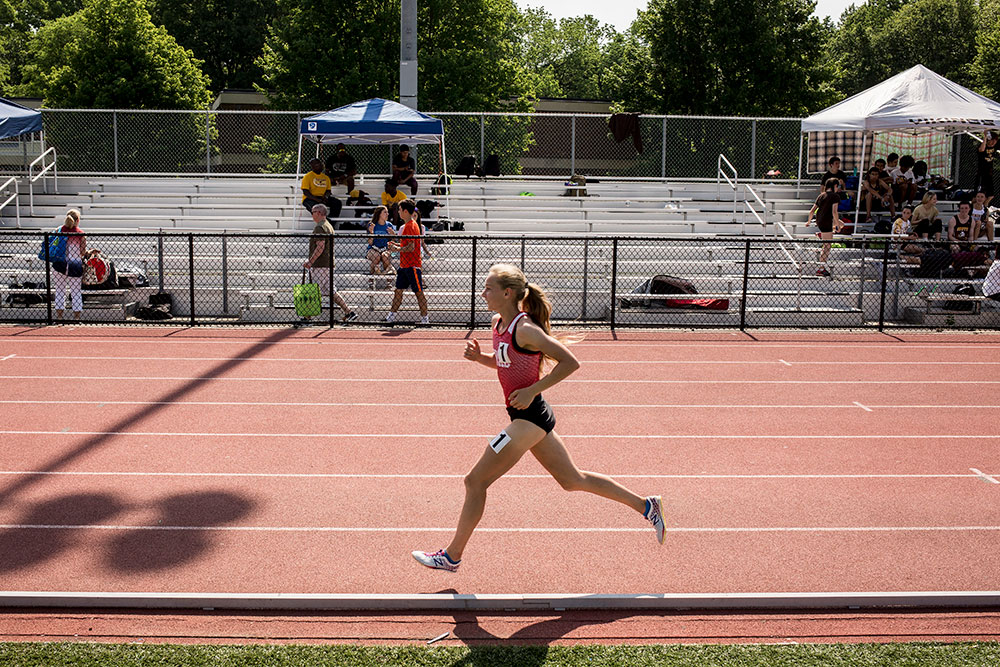
As many legacy news organizations narrow their focus to men’s pro sports because of budget and staff cuts, it presents an opportunity for female-focused sports websites and sports media startups. Take EqualizerSoccer.com. The website does impressive work covering women’s soccer in North America. It offers news stories, analysis, and podcasts on the National Women’s Soccer League, U.S. women’s national team, Canadian women’s soccer, and NCAA women’s competitions. Meanwhile, The Athletic is beginning to invest more in women’s sports coverage because of critics and subscriber feedback. Demand for more Lynx coverage prompted The Athletic to assign two writers to cover the team. Subscribers also wanted more stories on the U.S. women’s soccer team. Now, the site has two writers focusing on that team for the soccer vertical. And, according to chief content officer Fichtenbaum, discussions are under way about what’s next.
As The Athletic’s media reporter, Deitsch finds hope for the future of women’s sports coverage in additions to the sports media landscape like Her Hoop Stats and podcasters like the women behind “Burn It All Down.” They give a glimpse of what could encourage disruptive innovation in women’s sports coverage.
At the moment, it might be hard to imagine a feminist podcast moving from its niche with nearly 3,200 weekly downloads to a larger audience. But after the U.S. Open women’s final, when discussions about Serena Williams and sexism dominated the news cycle and after the Cristiano Ronaldo rape case made international headlines, it’s clear there is a larger audience for the kind of conversations and unique perspectives found consistently on “Burn It All Down.” Each podcast features an interview with a female sports reporter or prominent female sports figure, as well as the “Badass Woman of the Week” which usually highlights the accomplishments of a women’s team or female athlete.
And, of course, there’s the “Burn Pile” segment. That’s the point in each show when, as the co-hosts say, they virtually “pile up all the things we hated this week in sports and set them aflame.” The burn pile typically draws attention to discrimination, inequality, and bad behavior in the sports world. Overall, the roughly hour-long episodes are entertaining, thought-provoking, and potentially disruptive.
“I certainly hope the podcast is disruptive,” says co-host Shireen Ahmed. “Sports media definitely needs to be disrupted.” Ahmed, a freelance writer and sports activist based in Toronto, says the podcast started because the co-hosts were disappointed with the sports coverage they consumed. “We couldn’t help but look at sports with a critical lens,” says Ahmed. “What that means is the systems of racism, misogyny, homophobia, xenophobia that exist in sports, we want to burn them down.” Ahmed also wants to “change the face of what sports media can look like.” She’s a woman of color and Muslim and says, “I don’t look like I would be a sports writer. I don’t look like I take in sports with a critical lens. But I am and I do.” The podcast gives her an opportunity to broadcast that.
It takes all kinds of outlets, platforms, and advocates to improve coverage…above all, it takes a certain kind of journalistic courage and commitment
So, what does the future of women’s sports coverage look like? Maybe it will look a lot like October 17 when four of the top 10 stories on the Associated Press sports app featured women in sports. That happened even with the MLB playoffs nearing the World Series and the NBA regular season starting. Given its global reach and its business model, the AP and its stories exert more influence in the sports media world than a big city paper covering a successful WNBA team.
Still, it takes all kinds of outlets, all kinds of platforms, all kinds of advocates to improve coverage. It takes outlets like the “Burn It All Down” podcast, platforms like Her Hoop Stats, and advocates like Cheryl Reeve to show what women’s sports coverage can be and what women in sports can do. Above all, it takes a certain kind of journalistic courage and commitment.
